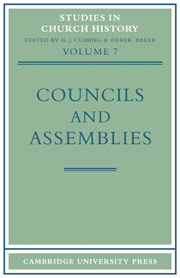Book contents
- Frontmatter
- Preface
- Contents
- Contributors
- Abbreviations
- Public welfare and social legislation in the early medieval councils (Presidential Address)
- National synods, kingship as office, and royal anointing: an early medieval syndrome
- The case of Berengar of Tours
- Ecclesiastica and Regalia: Papal investiture policy from the Council of Guastalla to the First Lateran Council, 1106–23
- Viri religiosi and the York election dispute
- Councils and synods in thirteenth-century Castile and Aragon
- The Byzantine reaction to the Second Council of Lyons, 1274
- The Council of London of 1342
- Education in English ecclesiastical legislation of the later Middle Ages
- The representation of the universitas fidelium in the councils of the conciliar period
- Nicholas Ryssheton and the Council of Pisa, 1409
- The condemnation of John Wyclif at the Council of Constance
- Some aspects of English representation at the Council of Basle
- The Council of Basle and the Second Vatican Council
- The Colloquies between Catholics and Protestants, 1539–41
- King James I's call for an ecumenical council
- John Hales and the Synod of Dort
- Assembly and Association in Dissent, 1689–1831
- The Convocation of 1710: an Anglican attempt at counter-revolution
- Laymen in synod: an aspect of the beginnings of synodical government in South Africa
- The First Vatican Council
- Kikuyu and Edinburgh: the interaction of attitudes to two conferences
The Council of Basle and the Second Vatican Council
Published online by Cambridge University Press: 12 March 2010
- Frontmatter
- Preface
- Contents
- Contributors
- Abbreviations
- Public welfare and social legislation in the early medieval councils (Presidential Address)
- National synods, kingship as office, and royal anointing: an early medieval syndrome
- The case of Berengar of Tours
- Ecclesiastica and Regalia: Papal investiture policy from the Council of Guastalla to the First Lateran Council, 1106–23
- Viri religiosi and the York election dispute
- Councils and synods in thirteenth-century Castile and Aragon
- The Byzantine reaction to the Second Council of Lyons, 1274
- The Council of London of 1342
- Education in English ecclesiastical legislation of the later Middle Ages
- The representation of the universitas fidelium in the councils of the conciliar period
- Nicholas Ryssheton and the Council of Pisa, 1409
- The condemnation of John Wyclif at the Council of Constance
- Some aspects of English representation at the Council of Basle
- The Council of Basle and the Second Vatican Council
- The Colloquies between Catholics and Protestants, 1539–41
- King James I's call for an ecumenical council
- John Hales and the Synod of Dort
- Assembly and Association in Dissent, 1689–1831
- The Convocation of 1710: an Anglican attempt at counter-revolution
- Laymen in synod: an aspect of the beginnings of synodical government in South Africa
- The First Vatican Council
- Kikuyu and Edinburgh: the interaction of attitudes to two conferences
Summary
Many will have noticed how the renewal of the Church in modern times has drawn together strands of thought and behaviour that were in the past considered discordant. Thus the Second Vatican Council, it seems, in continuing the work of the First, would be likely to draw on that part of the Church's heritage which had previously been in apparent conflict with the doctrine of papal supremacy: namely, the notion of the supremacy of the Church as a body and of the council or the episcopate. In some ways there is a remarkable degree of continuity between the thought of the Council of Basle (1431–49) and of the Second Vatican Council.
One of the central ideas of the Council of Basle, an idea to which it consistently resorted as its final justification, was the corporate sovereignty of the church community taken as a whole. It used this as a basis for conciliar sovereignty, on the grounds that the council was this whole church community ‘taken collectively’, in the literal sense of being assembled in one place. (This somewhat arbitrary identification of the council with the Church was largely the result of exaggerating the analogy between the whole Church and a small college or corporation.) But it was on the idea of the ultimate sovereignty of the community as a whole that Basle frequently, and increasingly, fell back in justifying the sovereignty of the council over the pope. We find this in Panormitanus (citing Zabarella), in Andrew of Escobar, in several statements by universities, in particular by Cracow, and most persistently in John of Segovia: ‘supreme power…belongs to the Church continuously, permanently, invariably, and perpetually’.
- Type
- Chapter
- Information
- Councils and Assemblies , pp. 229 - 234Publisher: Cambridge University PressPrint publication year: 1970



